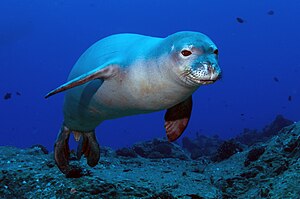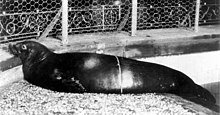Monk seals
| Monk seals | ||||||||||||
|---|---|---|---|---|---|---|---|---|---|---|---|---|

Hawaiian monk seal ( Neomonachus schauinslandi ) |
||||||||||||
| Systematics | ||||||||||||
|
||||||||||||
| Scientific name | ||||||||||||
| Monachini | ||||||||||||
| Gray , 1869 |
As monk seals (Monachini) three all year occurring in tropical and subtropical ocean regions species from the family of earless seals referred (Phocidae). They are common in very different regions of the world, but rare everywhere. The following three types are known:
- Mediterranean monk seal , Monachus monachus (Hermann 1779)
- Hawaiian monk seal , Neomonachus schauinslandi (Matschie 1905)
- Caribbean monk seal , Neomonachus tropicalis (Gray 1850)
Until recently, all monk seals were placed in the genus Monachus . In May 2014, the genus Neomonachus was established for the Hawaiian monk seal and the Caribbean monk seal . The reason for this was that the evolutionary gap between the Hawaiian monk seal and the Caribbean monk seal on the one hand and the Mediterranean monk seal on the other hand is exactly as large as or greater than between other sister genera of the dog seals . The monk seals no longer belong to the same genus, but continue to form a genus group , since Monachus and Neomonachus are sister genera . The generic name Neomonachus is made up of Monachus and the Greek neo (from ancient Greek νέος néos 'new') and indicates the new genus and the habitat in the western hemisphere ( New World ).
The genus Neomonachus was created by the Society for Marine Mammalogy. and recognized by the IUCN in the year of description.
The reason for naming monk seals can no longer be understood today. One attempt to explain it is that the layer of fat in the neck area is supposed to be reminiscent of a monk's robe.
Mediterranean monk seal
→ Main article: Mediterranean monk seal
The only seal in the Mediterranean has become extremely rare due to persecution. The IUCN estimates the remaining population at 350 to 450 individuals, making the Mediterranean monk seal one of the rarest mammals in Europe, along with the Saimaa ringed seal .
Hawaiian monk seal
→ Main article: Hawaiian monk seal
Once common on all coasts of the Hawaiian Islands, this species has now been pushed back to the small, uninhabited Leeward Islands in the northwest of the archipelago . Only five of the islands are rearing cubs, but outside the breeding season the seals wander far and wide, reaching the beaches of the main islands of the Hawaiian chain.
Hawaiian monk seals are 220 cm long and 170 kg (males) and 270 kg (females). The color is slate gray on the top and light gray on the underside. The animals live solitary and mate in the water. After the females throw their young on the beach, they stay with him to suckle it for about 40 days. During this time they lose up to 90 kg of body weight.
The constant pursuit by humans had reduced the population so much that the Hawaiian monk seal was believed to be extinct in 1824. The stocks on small and remote islands, including the Midway Islands, remained undiscovered . In the 1950s the population was estimated at 150 animals. When the Midway Islands were largely leveled for the construction of an air force base, the population there also disappeared. Since then, the small Leeward Islands and the Kure Atoll are the only remaining distribution areas. Through protective measures, u. a. The entire chain of islands was named Papahānaumokuākea Marine National Monument in 2006, and there were now 1,200 Hawaiian monk seals again, whose greatest threat no longer appears to be humans, but shark attacks .
Caribbean monk seal
→ Main article: Caribbean monk seal
The Caribbean monk seal is very likely to be extinct . Columbus already described the encounter with this seal after his first trip, which was the first mammal in the New World discovered by the Spaniards. It was common throughout the Caribbean and the Gulf of Mexico . A colony of Caribbean monk seals was last seen in 1952 on the Seranilla sandbar (south of Jamaica). Since then, there have been no scientifically proven sightings, although fishermen occasionally claim to have sighted these seals. However, scientific search expeditions to rediscover this species of seal have not produced any positive results. In 2008 the species was officially declared extinct by the US government.
Systematics
Numerous zoologists have described the monk seals as particularly "primitive" seals. Bonner even goes so far as to call the genus, and in particular the Hawaiian monk seal, "living fossils". Various anatomical details have led to the assumption that monk seals must be a particularly ancient group. In contrast to other seals, there is no enlargement of the petrous bone that surrounds the inner ear; this enlargement is interpreted as an adaptation to hearing underwater; the lack of this feature thus indicates an incomplete adaptation. In addition, the calf and shin bones are not fused at the end of the knee - a feature that monk seals have in common with land predators. Whether all these features really indicate a basal position of the monk seals has recently been disputed again.
According to Wyss (1988), the Mediterranean monk seal and the Caribbean monk seal are more closely related to other dog seals than to the Hawaiian monk seal. Accordingly, Monachus would be a paraphyletic taxon . The lines apparently separated 15 million years ago when Central America closed and the sea between the Atlantic and the Pacific was lost.
Bininda-Emonds and Russell came to the opposite conclusion in their cladistic analyzes of the dog seals in 1996. In their opinion, the monk seals are very much monophyletic . The frequently expressed representation of the monk seals as a basic or even particularly “primitive” group within the dog seals could also not be confirmed in the study.
literature
- Ronald M. Nowak: Walker's Mammals of the World . 6th edition. Johns Hopkins University Press, Baltimore 1999, ISBN 0-8018-5789-9 (English).
- KW Kenyon: Monk seals - Monachus . In: SH Ridgway & R. Harrison: Handbook of marine mammals. Vol. 2: Seals Academic Press London 1981.
- Nigel Bonner: Seals and Sea Lions of the World . Facts on File, 1994 ISBN 0816029555 .
- AR Wyss: On retrogression in the evolution of the Phocinae and phylogenetic affinities of monk seals . In: American Museum Novitates 1988, No. 2924, p. 38ff.
- Olaf RP Bininda-Emonds & AP Russell: A morphological perspective on the phylogenetic relationships of the extant phocid seals (Mammalia: Carnivora: Phocidae) . In: Bonn Zoological Monographs 1996, Vol. 4.
- Judith E. King : The monk seal genus Monachus. Bulletin of the British Museum of Natural History (Zoology) 3, 1956, pp. 203–256 ( PDF )
Individual evidence
- ↑ Dirk-Martin Scheel, Graham Slater, Sergios-Orestis Kolokotronis, Charles Potter, David Rotstein, Kyriakos Tsangaras, Alex Greenwood, Kristofer M. Helgen: Biogeography and taxonomy of extinct and endangered monk seals illuminated by ancient DNA and skull morphology. ZooKeys 409 (2014), pages 1–33, doi: 10.3897 / zookeys.409.6244
- ^ Committee on Taxonomy. 2014. List of Marine Mammal Species & Subspecies ( Memento of the original from January 6, 2015 in the Internet Archive ) Info: The archive link has been inserted automatically and has not yet been checked. Please check the original and archive link according to the instructions and then remove this notice. Society for Marine Mammalogy, www.marinemammalscience.org, accessed April 16, 2015.
- ^ Neomonachus in the IUCN Red List of Endangered Species . Retrieved April 23, 2015.


